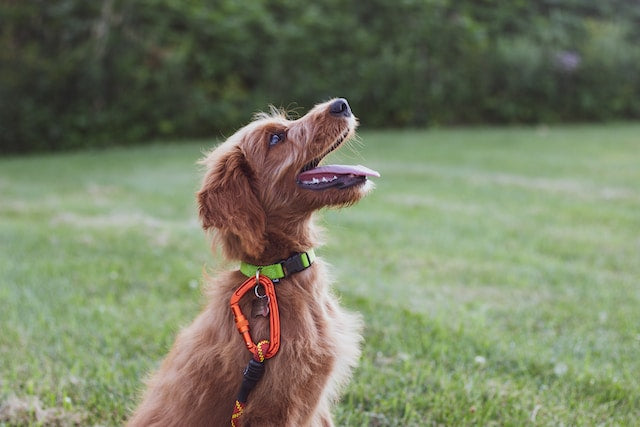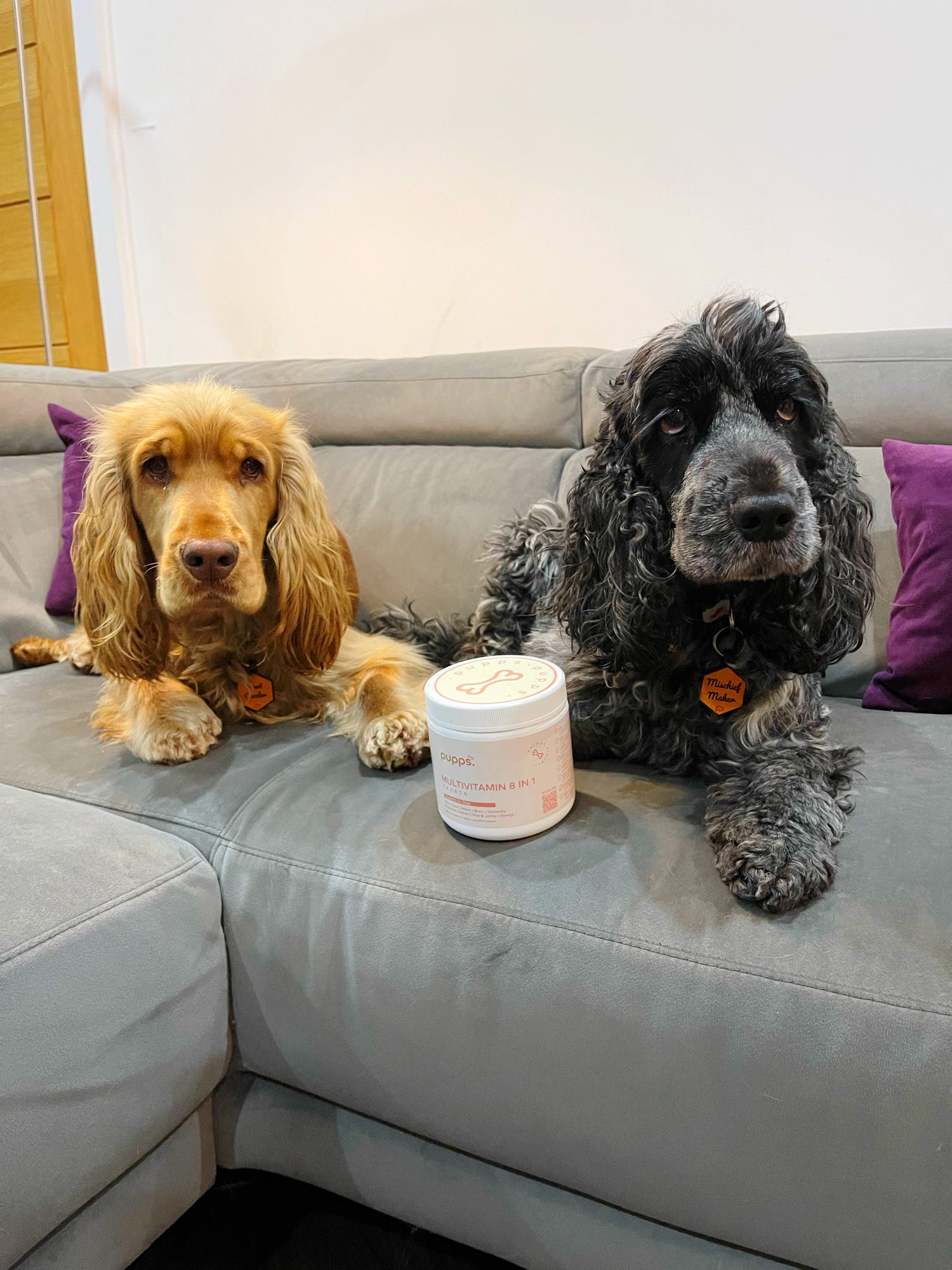Welcome to Pupps, your trusted source for canine health and wellness. In the delightful journey of training your loyal companion, treats play a pivotal role. Across the United Kingdom, countless dog owners rely on treats as a training tool, but they often fall prey to common missteps. In this comprehensive guide, we aim to shed light on the seven prevalent mistakes when using puppy treats for dog training. At Pupps, we prioritise the health and happiness of your furry friend, and this guide will help you navigate the world of dog training treats with precision and care.
Mistake #1: Overuse of Treats
The Lure of Treats: Imagine a picturesque scene in British parks – dog owners generously distributing treats to their furry companions, all with the hope of achieving desired behaviours. There's no doubt that treats serve as an excellent way to motivate and reward your dog during training sessions. However, it's essential to be mindful of the allure of treats, as overindulgence can lead to significant health concerns such as obesity and a heavy reliance on treats for obedience. At Pupps, we emphasise the need to use treats judiciously, striking a delicate balance between using them as an effective training aid and preventing them from becoming a health hazard.
Prioritising Health: With the alarming rise in dog obesity across the UK, it has never been more critical to strike a harmonious balance between rewarding your pet and maintaining their overall well-being. In this section, we will dive deeper into strategies for using treats effectively while safeguarding your pet's health. We'll provide valuable insights into the importance of portion control, the selection of healthy treat options, and the incorporation of a well-rounded diet into your dog's daily training routine.
Portion Control: One of the key aspects of responsible treat usage is portion control. It's easy to lose track of how many treats you've given your dog, especially during an enthusiastic training session. To maintain a healthy weight and prevent overindulgence, consider using smaller-sized treats or breaking larger treats into smaller pieces. This way, you can reward your pup without overloading them with unnecessary calories.
Healthy Treat Options: Not all treats are created equal, and it's crucial to choose wisely. Opt for high-quality treats that are not only delicious but also nutritionally beneficial. Look for treats made from wholesome ingredients, preferably with real meat as the primary source of protein. Avoid treats with excessive fillers, artificial additives, or preservatives. At Pupps, we offer a range of nutritious treats that cater to your dog's taste buds while supporting their health.
Balanced Diet: Treats should complement your dog's regular diet, not replace it. Ensure that your furry friend receives a balanced and nutritious diet as the foundation of their well-being. Consult with your veterinarian to determine the ideal daily calorie intake for your dog, taking into account their age, size, and activity level. By incorporating treats thoughtfully into their diet, you can strike the right balance between reward and health.
Mistake #2: Inconsistency in Training
The Lure of Treats: Imagine a picturesque scene in British parks – dog owners generously distributing treats to their furry companions, all with the hope of achieving desired behaviours. There's no doubt that treats serve as an excellent way to motivate and reward your dog during training sessions. However, it's essential to be mindful of the allure of treats, as overindulgence can lead to significant health concerns such as obesity and a heavy reliance on treats for obedience. At Pupps, we emphasise the need to use treats judiciously, striking a delicate balance between using them as an effective training aid and preventing them from becoming a health hazard.
Prioritising Health: With the alarming rise in dog obesity across the UK, it has never been more critical to strike a harmonious balance between rewarding your pet and maintaining their overall well-being. In this section, we will dive deeper into strategies for using treats effectively while safeguarding your pet's health. We'll provide valuable insights into the importance of portion control, the selection of healthy treat options, and the incorporation of a well-rounded diet into your dog's daily training routine.
Portion Control: One of the key aspects of responsible treat usage is portion control. It's easy to lose track of how many treats you've given your dog, especially during an enthusiastic training session. To maintain a healthy weight and prevent overindulgence, consider using smaller-sized treats or breaking larger treats into smaller pieces. This way, you can reward your pup without overloading them with unnecessary calories.
Healthy Treat Options: Not all treats are created equal, and it's crucial to choose wisely. Opt for high-quality treats that are not only delicious but also nutritionally beneficial. Look for treats made from wholesome ingredients, preferably with real meat as the primary source of protein. Avoid treats with excessive fillers, artificial additives, or preservatives. At Pupps, we offer a range of nutritious treats that cater to your dog's taste buds while supporting their health.
Balanced Diet: Treats should complement your dog's regular diet, not replace it. Ensure that your furry friend receives a balanced and nutritious diet as the foundation of their well-being. Consult with your veterinarian to determine the ideal daily calorie intake for your dog, taking into account their age, size, and activity level. By incorporating treats thoughtfully into their diet, you can strike the right balance between reward and health.
Mistake #3: Using Low-Quality Treats
Nutrition Matters: While it may be tempting to opt for budget-friendly treats, it's essential to consider their nutritional value. At Pupps, we understand that your dog's health is of paramount importance. Using low-quality treats can have detrimental long-term effects on your dog's overall well-being. In this section, we'll guide you through the process of selecting high-quality, nutritious treats that not only support your dog's training goals but also contribute to their long-term health.
Quality over Cost: It's easy to be swayed by the allure of inexpensive treats, but it's crucial to look beyond the price tag. Investing in high-quality treats is an investment in your dog's health and happiness. Premium treats are often made from superior ingredients that provide essential nutrients while being gentle on your dog's digestive system.
Balanced Nutrition: When selecting treats, consider their nutritional value. Look for treats that offer a balanced combination of protein, fats, and carbohydrates. These macronutrients are essential for your dog's energy, growth, and overall vitality. High-quality treats contribute positively to your dog's daily nutritional intake.
Understanding Ingredients: In this section, we'll break down what to look for in a treat, from protein content to the presence of artificial additives. We'll provide you with the knowledge you need to make informed choices for your beloved furry friend, ensuring their health remains a top priority.
Protein Content: Protein is a fundamental component of your dog's diet, and it should be a prominent ingredient in their treats. Look for treats that list a high-quality source of protein, such as real meat, as the main ingredient. Protein supports muscle development and overall health.
Natural Ingredients: Choose treats that are free from artificial additives, preservatives, and fillers. Artificial ingredients can be harsh on your dog's digestive system and may lead to allergies or sensitivities. Natural treats are not only healthier but also tastier for your pup.
Allergen Consideration: If your dog has specific food allergies or sensitivities, pay close attention to the treat's ingredients. Many high-quality treats are available in allergy-friendly options, ensuring that your dog can enjoy delicious rewards without any adverse reactions.
Mistake #4: Not Varying Treats
Keeping Training Exciting: Variety is indeed the spice of life, and this principle applies to our furry friends as well. Using the same treats repeatedly during training can lead to boredom and a lack of motivation in your dog. At Pupps, we understand the importance of keeping training sessions exciting and engaging for your canine companion. In this section, we'll explore how varying treats can maintain your dog's interest and enthusiasm throughout their training journey.
Avoiding Treat Fatigue: Just like humans, dogs can experience treat fatigue if they're consistently offered the same reward. They may become less interested and motivated to learn new commands. To combat treat fatigue, it's essential to introduce variety into your training routine.
A Range of Options: The world of dog treats offers a wide array of options, from crunchy biscuits to soft chews and everything in between. In this section, we'll go beyond the basics and offer creative ideas and alternatives to standard treats. These exciting alternatives can help you keep your training sessions fresh, ensuring that your dog remains eager to participate.
Rotate Flavours: Consider rotating treat flavours to pique your dog's interest. Opt for treats with different meat flavours or ingredients. For instance, if you've been using chicken-flavoured treats, switch to beef or salmon-flavoured ones. This variety adds a layer of excitement to training.
Experiment with Textures: Dogs have preferences when it comes to treat textures. Some may prefer crunchy biscuits, while others adore chewy or jerky-style treats. By experimenting with different textures, you can discover what your dog finds most enticing and tailor your rewards accordingly.
Homemade Treats: Homemade treats are an excellent way to introduce variety into your dog's training regimen. You can bake your own treats using dog-friendly ingredients like pumpkin, sweet potato, or peanut butter. Homemade treats allow you to control the quality of ingredients and provide a special touch to your dog's training experience.
Mistake #5: Rewarding Bad Behaviour
Accidental Reinforcement: One of the most challenging aspects of dog training is ensuring that you're not inadvertently rewarding undesirable behaviour. This unintended reinforcement can establish bad habits that are notoriously difficult to break. At Pupps, we're dedicated to helping you recognise and avoid these situations by emphasising the crucial role of timing and observation in effective training.
The Domino Effect: Dogs are quick learners, and they can associate rewards with actions rapidly. If you inadvertently reward bad behaviour, you're essentially reinforcing it. For instance, if your dog barks excessively for attention, giving in to their demands by offering treats or affection can reinforce this undesirable behaviour.
The Power of Timing: Timing is indeed everything in dog training. In this section, we'll discuss how to observe your dog's behaviour closely and reward them at the precise moment when they exhibit positive behaviour. Immediate reinforcement strengthens the connection between the action and the reward, making it more likely that your dog will repeat the desired behaviour in the future.
Redirect and Reinforce: Instead of inadvertently rewarding bad behaviour, learn to redirect your dog's actions towards positive alternatives. For example, if your dog jumps on guests as a sign of excitement, rather than scolding or pushing them away, teach your dog to sit and offer a reward for obeying the "sit" command. This way, you're reinforcing the desired behaviour while redirecting their energy.
Anticipate and Prevent: Effective training also involves anticipating situations where your dog might exhibit undesirable behaviour. By recognising triggers in advance, you can proactively prevent unwanted actions and redirect your dog's focus. For instance, if your dog tends to bark at the mail carrier, keep treats handy and reward them for remaining calm and quiet when the post arrives.
Mistake #6: Lack of Patience and Positive Reinforcement
The Virtue of Patience: Training a dog is a journey that demands a great deal of patience. Rushing the process or showing frustration can have adverse effects on your dog's progress. At Pupps, we'll emphasise the importance of patience and how it influences the effectiveness of your training sessions.
Embracing Positive Reinforcement: Positive reinforcement goes beyond just giving treats; it's about building a strong bond and understanding with your dog. In this section, we'll delve into how to use positive reinforcement effectively to foster a trusting and respectful relationship with your pet. You'll learn how to celebrate your dog's successes and motivate them to excel in their training.
Mistake #7: Ignoring Non-Food Rewards
Beyond Treats: While it's undeniable that treats are effective motivators during dog training, it's important to recognise that they are not the sole means of rewarding your dog. Other forms of rewards, such as playtime, affection, and verbal praise, hold equal value in motivating and reinforcing positive behaviour. At Pupps, we're committed to exploring alternative rewards and shedding light on their significance in shaping your dog's behaviour.
The Value of Non-Food Rewards: Dogs thrive on a range of rewards, and each dog may have their unique preferences. While treats are tangible and delicious, non-food rewards tap into your dog's emotional needs. Playtime, affectionate pats, and heartfelt praise can be just as motivating as a tasty treat, if not more so.
A Balanced Approach: Finding the right balance between food and non-food rewards is key to successful training. In this final section, we'll offer guidance on how to blend different types of rewards to keep your training sessions engaging and effective. By incorporating a variety of rewards into your training regimen, you'll ensure that your dog remains eager to learn and please you.
Playtime as a Reward: For many dogs, playtime is the ultimate reward. Engaging in interactive play sessions with toys like balls, frisbees, or tug ropes not only reinforces good behaviour but also fosters a deeper bond between you and your dog. Incorporating play as a reward can make training sessions enjoyable and mentally stimulating for your pet.
Affection and Praise: Never underestimate the power of a pat on the back or a heartfelt "good dog!" Dogs thrive on affection and seek validation from their human companions. Lavishing your dog with genuine praise and affection reinforces their positive behaviour and boosts their self-esteem.
Verbal Rewards: Verbal praise is a versatile and readily available form of reward. A few encouraging words, spoken in an upbeat tone, can convey your approval and motivate your dog. Consistent verbal cues like "well done" or "bravo" paired with physical gestures can become powerful signals of success in your dog's training journey.
Pupps' Multivitamin 8in1 Treats
If you're on the hunt for high-quality treats that deliver more than just a tasty snack for your pooch, our Multivitamin 8in1 treats are a must-try. Expertly crafted to blend deliciousness with nutrition, these treats are a top-notch way to pamper your dog while ensuring they're getting a powerhouse of essential vitamins and minerals. Each treat is packed with a carefully selected blend of ingredients, including Glucosamine, Alaskan Salmon Oil, MSM, COQ10, Chondroitin, a 5 Blend Probiotic, and a spectrum of essential vitamins like Vitamin C, B1, B2, B3, B5, B6, B7, B9, and B12.
This unique combination not only supports your dog's physical health but also contributes to their overall wellbeing. From maintaining healthy joints and a shiny coat to supporting digestive health and boosting their immune system, our Multivitamin 8in1 treats are an all-in-one solution. Plus, they're made with the highest quality ingredients, ensuring that your furry friend is enjoying a treat that's as healthy as it is delicious.
By incorporating these treats into your dog's diet, you're not just giving them a treat; you're investing in their long-term health and happiness. So, if you want to reward your dog and provide them with the nutritional support they need, these treats are the perfect choice.




Leave a comment
This site is protected by hCaptcha and the hCaptcha Privacy Policy and Terms of Service apply.